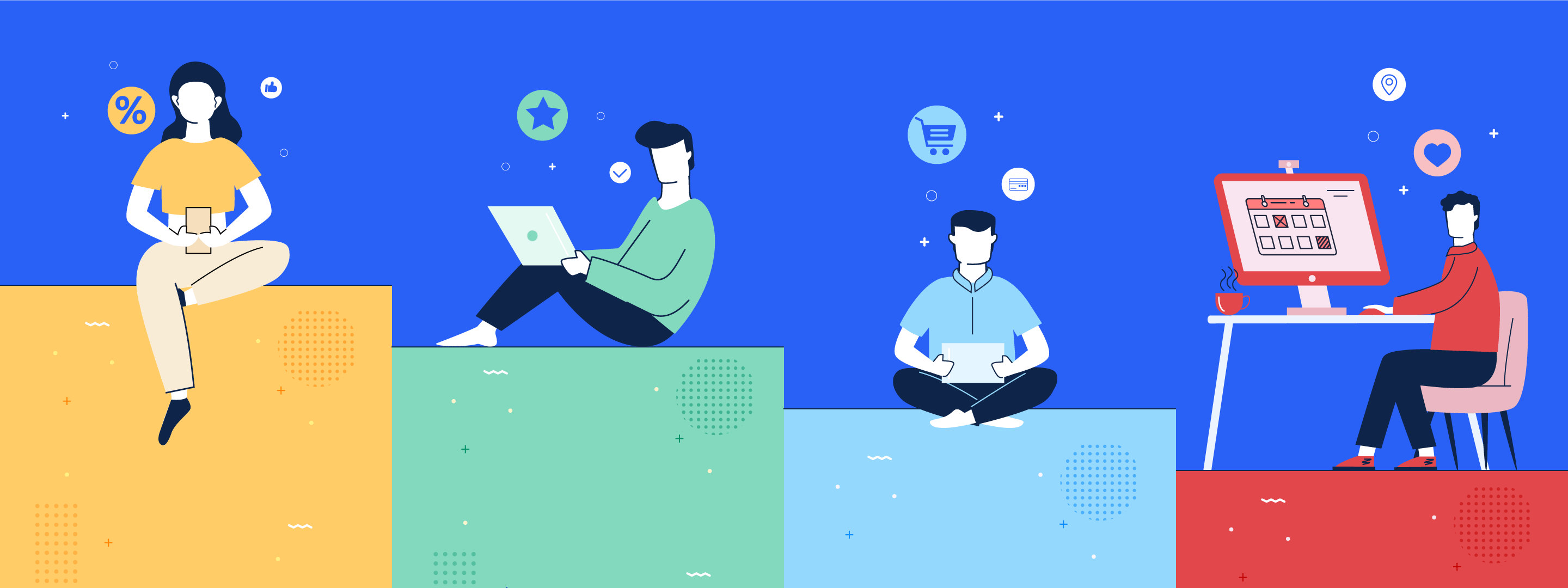When only 22% of businesses are satisfied with their conversion rates and on average, a typical website conversion rate is 2.35% only (Wordstream), you wouldn’t be hard pressed to imagine why you are always on the hunt for conversions.
Audiences are fast embracing banner blindness, are simply ignoring regular TV ads and skipping banner ads on websites. This is why personalization is the new standard. And it will require you to go one step further from user segmentation based on demographics to segmentation based on behavior.
Behavioral segmentation allows you to dig deeper into your customers’ psyche and convert them. This article shares the methods, tools, and common examples of behavioral segmentation.
- How to segment your audience?
- Types of customers based on their decision-making factors
- Going beyond typology
- Best practices for behavioral segmentation
How to segment your audience?

Let’s assume that a group of your app users only reinstall the app or visit the website, a week before major holidays. From this, you can infer that these people are driven by occasion or hunt for a bargain. From this, you can infer that these people are driven by occasion or hunt for a bargain. And you can then use these audience insights to increase your sales during the discount season by re-marketing to these people.
But before you make any conclusions, you need to gather a lot of data. Since you want to cover both existing and prospective customers, here’s where you need to look for the data:
- Sales reports to see when and how much each lead is buying. Are they a returning customer?
- Website usage to see how regular a particular user is on your website. This is extremely important if you have a blog or a widget people can use for free.
- App usage can help find the most frequent users. Using the app in a particular time of the day or on special or designated days is also a telling sign.
- Email tracking to know about people who open, read, and convert from your emails. The ones that do are your top priority.
- Social media usage to identify the top fans and regular users of your services. Connect social media profiles to leads in your CRM to get more precise results.
When you’re looking for data, try to answer these questions:
- Is this person already a customer?
- Where do they stand in the sales funnel?
- What device do they use to view the app or website?
- Do they convert and follow through with the payment?
- How frequently do they use it?
- When do they use it?
- What features do they mostly use?
- How loyal are they?
- How price-sensitive are they?
Once you obtain data to answer all these questions, start looking for patterns.
While you can potentially find any type of correlation in your data, there are 4 main types of customers according to what drives their purchasing decisions:
Types of customers based on their decision-making factors
Traditionally, customers can be divided into 4 categories on the basis of how they interact and purchase from you.
-
Loyal customers
65% of your income comes from loyal customers. This is why figuring out this behavioral segment of your customer base is crucial for your success. People who buy from you often, who often use the website and the app, and share your content on social media, fall into this category.
You can also segment customers more directly by measuring customer satisfaction score and net promoter score (NPS). Both of these metrics correlate with brand loyalty.
Why is finding customers who belong to this category important? Simply because you need to improve retention for these customers at all costs. And one of the easiest ways to do this is to offer loyalty points.

The more a person buys from you, the more benefits they get.
Since 65% of your company’s profits come from loyal customers, you’re not really losing anything by offering deals to them. Share on X-
Occasion-based customers
The second way of segmenting users’ purchasing behavior is to find one-time or recurrent customers and find a temporal correlation in their purchasing decisions. Sorting people into this category is easy if a customer makes a purchase or downloads your app around holidays like Christmas or Black Friday, or on their birthday.
If they base their purchases around a loved one’s birthday or a family occasion, it can be harder to decipher as that data pointer will not be available on your platform. But even in this case, you can still re-market to them, near the common date of purchase, if you have data of past two years, at least.
Note that many of your customers will buy something during the holidays. The occasion-based ones will buy exclusively during that time.
-
Benefit-based customers
This segment of your clientele bases their purchasing decisions on the benefits they receive. The most prominent part of this segment are the price-sensitive buyers. You can clearly identify their purchasing patterns because they primarily make purchases when there’s a discount.

Note that this demographic differs from the occasion-based buyers because the latter only takes discounts on special occasions. The price-sensitive bunch will be excited to receive any discount at any point of time.
As for other benefits, it can be harder to trace. An example of benefit-based segmentation is grouping the discount chasers of a cosmetics company by the type of skin they have, based on what products they buy.
-
Usage-based customers
Usage frequency is the simplest segmentation you can make. Categorize users into heavy, medium, and light by the amount of time they spend on the website or the frequency of purchase.
The exact connotations of this segment vary depending on the type of app or website you have. For mobile games monetized via ads, heavy users are the basis for ad revenue. For a blog website, heavy users may be readers, but not customers, so you may not get a ton of revenue from them.
Going beyond typology
These four types are a great basis for behavioral segmentation, but you shouldn’t be confined to them. While you analyze the data, you may find a correlation that’s not described by the four basic categories, and that’s okay.
Your goal is not to sort your customers into either of these 4 types. That’s the base level of behavioral segmentation. Your goal is to find correlation in data.
Amazon doesn’t stick to the four types alone. The company looks for patterns in purchasing behavior and uses that as a basis to offer products that may be interesting to a user.
For instance, the algorithm rules out that someone who is buying an outdoors grill may be more interested in new kitchenware than someone who’s buying a freezer.
This goes beyond the traditional typology but presents you with an opportunity for improvement.
Here’s how you can implement your findings in business.
Best practices for behavior segmentation
You may be sitting on a gold mine of customer data. You may have all the categories of customers figured out and all leads sorted into each category correctly. But it doesn’t improve your bottom line unless you actually implement the findings.
Here are four ways you can do that.
-
Forecasting
Past behavior predicts future behavior, at least to an extent. This makes behavior segmentation useful for any type of business forecasting. Pro Essay Writer, an aggregator that brings together content creators and editors, has to consider the behavior of both freelance editors and customers to ensure the platform runs in the most effective way.
The company’s insight was that most editors who are half-booked will accept new gigs only if they pay well. As a result, the freelancers were getting booked by the best bidders, and plenty of clients were having a hard time looking for a freelancer.
Understanding the problem allowed this company to tweak the system to serve the price-sensitive customers first and then move on to the loyal customer base. This solved the peak hour problems the company had.
-
Personalization
The transaction rate of personalized email are 6 times higher than the control group. Add behavior data to your list of segmentation factors, and you’ll be able to understand your customers even better.
Unique Open Rates for Emails with Personalized Subject Lines by Industry:

Make your personalization more effective with a marketing automation software. Set up personalized emails to be sent to customers when they do an action or trigger an event. Another bit of personalization you could do is to reach out to people who respond to your emails less often. When you do reach out, though, make it the best offer they can get so they become a customer again.
Keep the communication to the minimum so that when a message arrives, it’s at the time where the customer is ready to convert.
Bonus Read –Why Hyper-Personalization Is The Future Of Marketing (And How To Do It)
-
Suggestions
Take a lesson from Amazon, and upsell products to users based on their previous purchase patterns. Netflix uses the same type of behavioral segmentation for the recommended section. The algorithm looks for patterns in user behavior and uses the connectivity graph of their preferred series to form the recommended section.

While few people know how TikTok algorithms work, it’s safe to say they include some form of behavioral segmentation as well. Each user’s “For You” page is unique and is based on the content they’ve watched previously.
Follow the four main types of behavior segments and make suggestions based on what type the person falls into. Offer discounts to the benefit-based customers and timely reminders to the occasion-based ones, and you’re guaranteed to increase sales.
-
Lead qualification
Behavior segmentation lets you find correlation between user actions and conversion rates. This can mean everything for you if you’re a company that relies on the influx of leads that matter, rather than on numbers.
The marketing team at Cake HR Software came up with this lead qualification technique. When a qualified lead had many tabs open in their browser and was viewing the price list, the sales representatives received a notification in the CRM.
Why? Because having multiple tabs open usually means the person is researching the web for the best option to buy right now!
The call the representative made on that prompt was, in many cases, game-changing.
Know more about – what is behavioral segmentation
Conclusion
After reading this behavior segmentation guide, you should be on the right track to making your company’s message more personalized and more effective. Don’t stop there.
Iterate and split-test segmentation solutions and learn more about other ways to segment your audience.






